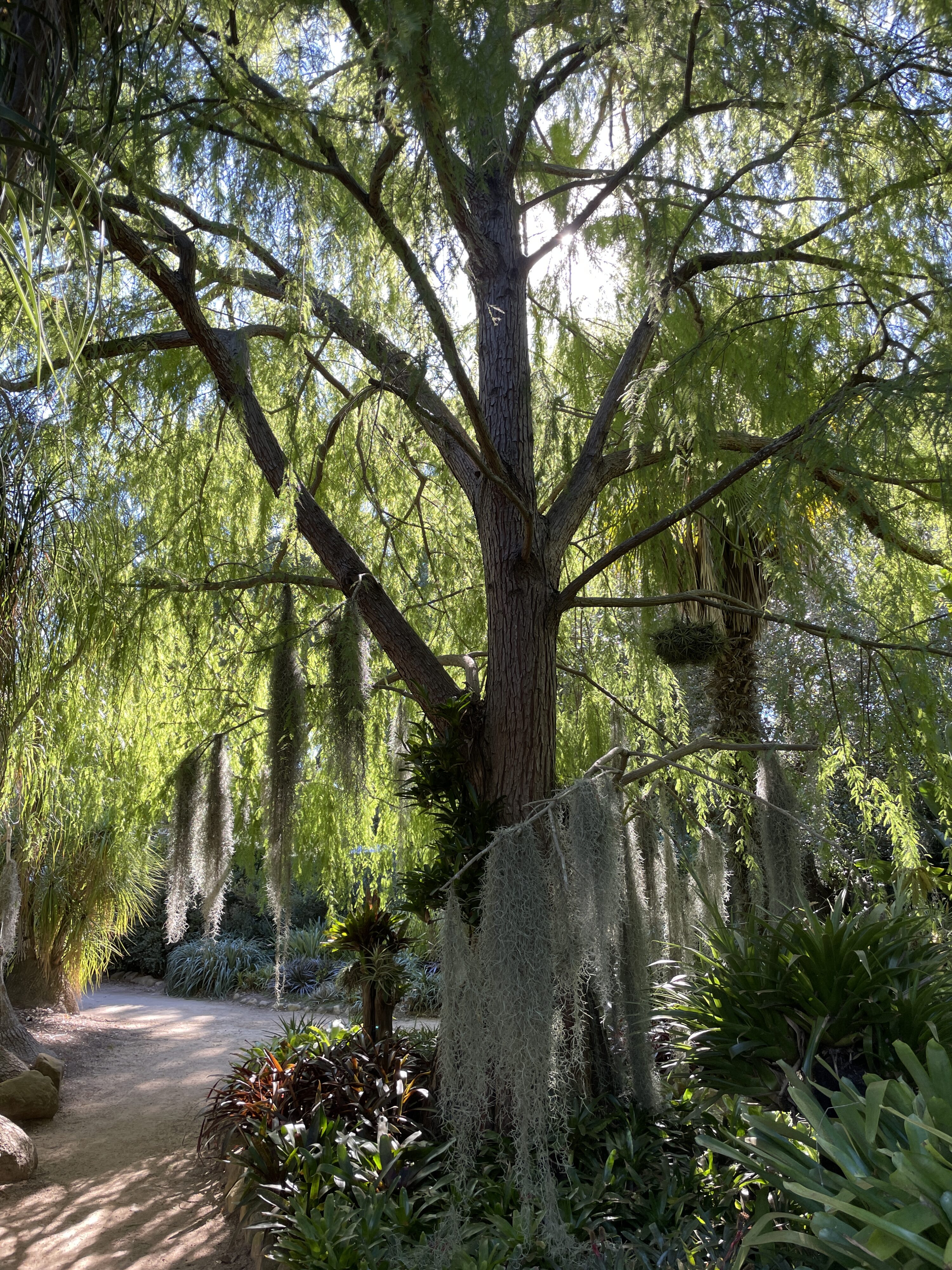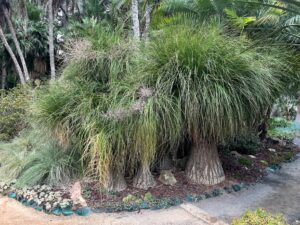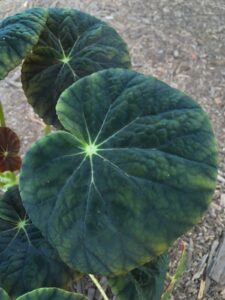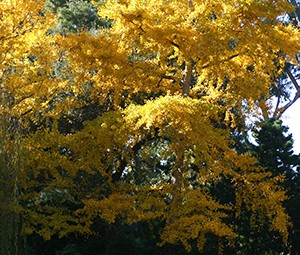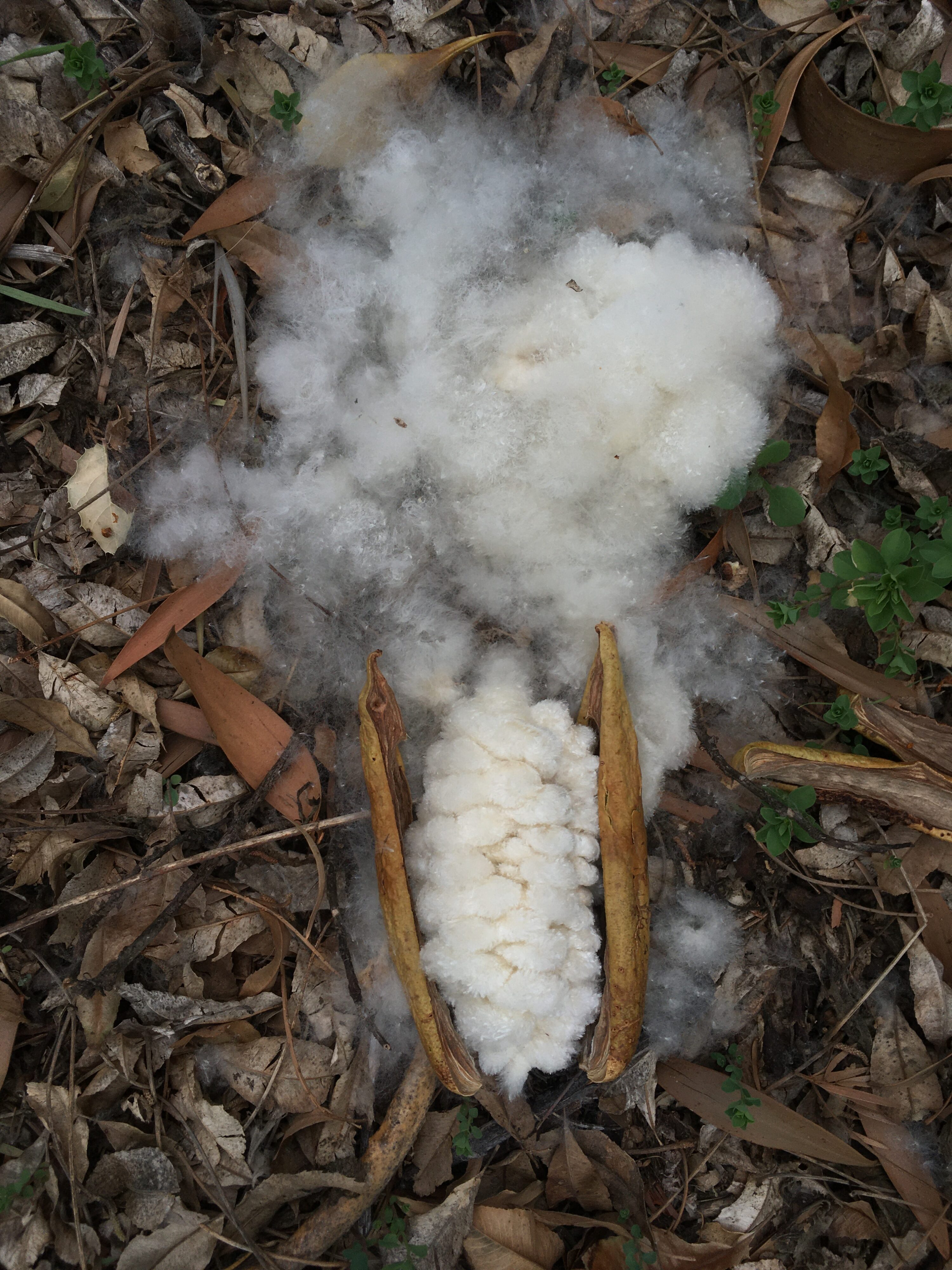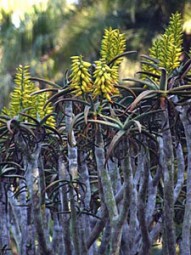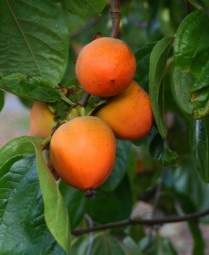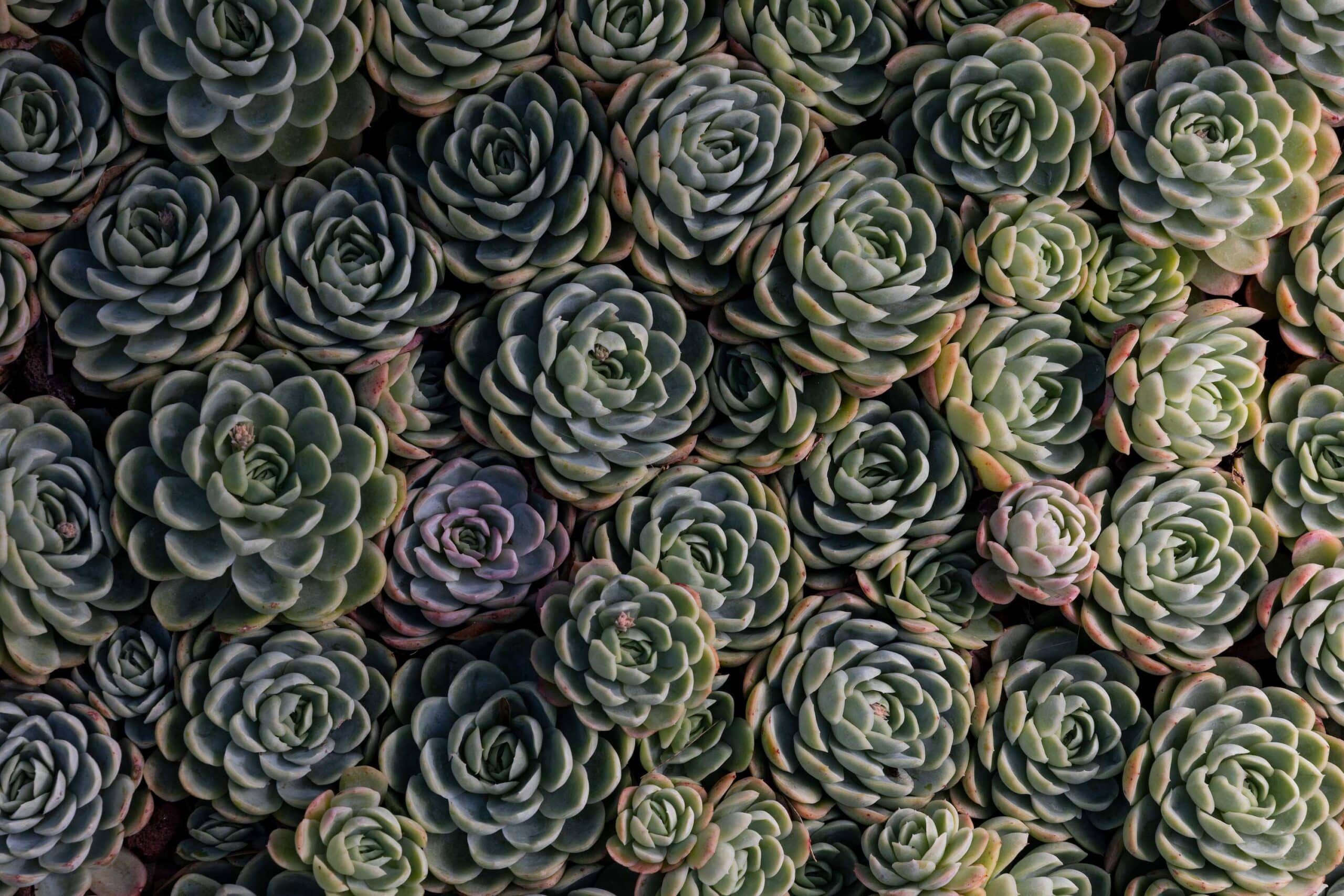
Plant Highlights
November
-
Taxodium mucronatum
Montezuma cypress, Mexican swamp cypress, ahuehuete, sabino
Highlight Month:
November
Nativity:
South Texas to Guatemala
Growth Habit:
The Montezuma cypress is the national tree of Mexico and makes a majestic addition to the garden with its wide buttressing trunk and soft foliage. This species is semi-deciduous to evergreen in Santa Barbara and the old foliage will turn orange-brown and drop as the new leaves emerge. The flat leaves (needles) are arranged pinnately or bi-pinnately on small deciduous branchlets that undergo cladoptosis (regular branch shedding), usually in the dry season in habitat. The tree develops a broad spreading crown and horizontal branches with age. T. mucronatum is a conifer and produces separate pollen cones (male) and seed cones (female) on the same plant. This species has been known to develop understated cypress “knees” but only in areas with a high water table.
The genus Taxodium is comprised of one to three species, depending on which taxonomic authority is referenced, and T. mucronatum is sometimes listed as T. distichum v. mexicanum or T. huegelii. The other two taxa in this genus are T. distichum (bald cypress) and T. distichum v. imbricarium (pond cypress). T. mucronatum differs from T. distichum by having smaller seed cones and stomata equally abundant on both sides of the leaf. Also, the crown spreads wider at an earlier age, it does not exhibit the sudden leaf/branchlet shedding of the other deciduous conifers, it has a needlelike point on the female cone scales, and has a distinct range. Because Taxodium are wind-pollinated, hybrids can occur in places of overlap. The genus name comes from the Latin, taxus (yew), and the Greek, eidos (similar to). The specific epithet comes from the Latin, mucro (sharp point), referencing the pointed needles of this species.
Growing Requirements:
It does not typically grow in standing water or swamps like other Taxodium. It is hardy to USDA Zone 8 but will experience some dieback with frost.
Features:
There are many celebrity Montezuma cypress in Mexico, including one designated as the stoutest tree in the world, the Árbol del Tule, in Oaxaca, with a diameter of 41.6 ft (30.8 ft not including the buttresses). Others include the now deceased El Arbol del Noche Triste and El Sargento, both in Mexico City. These trunks are still on display and protected behind fencing. A specimen in Chalma, Cuernavaca is used in religious pilgrimages and mass baptisms in a conveniently located adjacent stream.
T. mucronatum has many ethnobotanical uses and was used in the creation of artificial agricultural islands, or chinampas, in the formerly extensive Lake Texcoco in the Valley of Mexico. T. mucronatum and Salix bonplandiana were planted in a rectangular shape within the shallow lake and the enclosed area was mounded with soil for farming. The species also appears in Zapotec creation mythology. The bark is used as a diuretic, the leaves are used to cure scabies and as altar decorations, and the resin is used to treat ulcers, toothache, and skin diseases. The common name, ahuehuete, translates to “old man of the water.”
Where at Lotusland:
Montezuma cypress can be found in the Lower Bromeliad Garden, where it is adorned with Spanish moss (Tillandsia usneoides), and the Japanese Garden near the entrance closest to the Visitor’s Center.
-
xCalibanus hookeri
Highlight Month:
November
Nativity:
Lotusland Origin
Growth Habit:
Calibanus hookeri forms a low-growing corky fully to semi-subterranean caudex that can reach epic proportions with reports of plants rivaling the size of a Volkswagen Beetle. It was rediscovered in the wild by a group of botanists, including Charlie Glass and Bob Foster, in 1968 before they both came to work at Lotusland. Beaucarnea recurvata forms a similar enlarged caudex many feet in diameter but the trunk can reach 20’ in height. Fruit from the hybrid plants displays three small papery fins, like the membranous wings on B. recurvata fruit, but is also rounded like C. hookeri fruit. The hybrids form base diameters rivaling B. recurvata and short trunks with multiple branches. Both species are native to Mexico but are separated geographically by hundreds of miles. Interestingly, the genus Calibanus has now been incorporated into Beaucarnea by some authorities (Rojas-Piña et al., 2014).
Growing Requirements:
Full to part sun, well-drained soils.
Features:
This spontaneous hybrid Calibanus has mysterious origins at Lotusland and is thought to be an intergeneric hybrid between Calibanus hookeri and Beaucarnea recurvata. Its story begins in the late 1970s when seed was collected from a female Calibanus hookeri in the Succulent Garden by Charlie Glass, Lotusland’s first unofficial curator. Calibanus and Beaucarnea are dioecious, meaning they produce male and female flowers on separate plants. Initially, Charlie presumed the resulting seedlings were pure Calibanus hookeri, but they started showing irregular characteristics, leading him to believe the plant may have been pollinated with a nearby male B. recurvata. Eleven of the seedlings were planted in the Cycad Garden in 1979-80 and a few were relocated to the nursery in 2010 to make room for a Dioon installation. One of these original plants remains in the Cycad Garden today next to a mature B. recurvata, making for a nice comparison. There are additional hybrid specimens in the Succulent Garden but without proper documentation it is unknown if these were from the original cross or were later propagations.
Where at Lotusland:
Succulent Garden, Cycad Garden
-
Begonia ‘Yanonali’
Highlight Month:
November
Nativity:
Garden Origin
Growth Habit:
This rhizomatous begonia displays wrinkled blue-green leaves with reddish undersides held on erect stems.
Growing Requirements:
Shade, moist soils
Features:
Rudy Ziesenhenne, world-renowned begonia grower from Santa Barbara, hybridized this cultivar in 1975 and named it after the Chumash chief Yanonali. It is a hybrid of Begonia mazae and B. carrieae. Ziesenhenne operated a nursery from 1934-2005 where Santa Barbara Bowl box office is now located. He was responsible for naming 20 Begonia species and developing 74 hybrids. A native plant and begonia garden now surround the box office in his memory.
Where at Lotusland:
Fern Garden
-
Ginkgo biloba
maidenhair tree
Highlight Month:
November
Nativity:
Southeast China. Only two localities in China still hold wild populations of this ancient tree, but it has been a sacred plant for centuries and was probably saved from extinction through cultivation.
Growth Habit:
This deciduous tree can grow 65 to 80 feet in height. Leaves are fan-shaped, resembling the leaflets of maidenhair fern, thus the common name. Most cultivar selections of this species are male since female plants drop seeds with a malodorous fruit-like covering.
Growing Requirements:
Ginkgo require consistent moisture and can grow in full sun to partial shade. They are remarkably unaffected by urban smog and have been widely planted in Asia as street and park trees.
Features:
The fan-shaped leaves and turn a buttery yellow-gold in late fall. Ginkgo biloba is the only surviving species in its division Ginkgophyta. Fossil evidence suggests Ginkgo has remained generally unchanged for the last 270 million years and was once native to North America and throughout the world. Ginkgo biloba is widely grown in China and Japan for its medicinal, food and timber value. Female trees produce an edible seed covered in a nauseatingly smelly fleshy structure. Once cleaned, these seeds are roasted or included in bird’s-nest soup. Standardized extracts from the leaves are used to treat difficulties of concentration and memory, lack of energy, decrease physical performance, anxiety, dizziness, tinnitus and headache.
Where at Lotusland:
There are several mature trees, including one female plant, in the Japanese Garden. Another specimen has been pruned and trained in the niwaki style.
-
Ceiba speciosa
silk floss tree
Highlight Month:
July, November
Nativity:
It is native to tropical and subtropical forests in South America (NE Argentina, Bolivia, Paraguay, Uruguay, S. Brazil).
Growth Habit:
Ceiba speciosa is a large charismatic tree featuring a bottle-shaped trunk. It is fast-growing and can reach heights of 30’ in just a few years and will mature around 40-60’ tall. The green trunk develops large attractive grey prickles with age. In the fall, the tree loses its palmately compound leaves and erupts in an impressive display of pink hibiscus-like flowers with creamy-white centers. Large fruit capsules split open the following spring to release the seeds surrounded by cottony fluff that can be used as stuffing or insulation, hence the common name “silk floss tree.”
Growing Requirements:
Plant in full sun with good soil drainage and water sparingly.
Features:
The genus Ceiba comes from the Spanish interpretation of the Caribbean Taino word meaning “giant tree.” This species is also called “palo borracho” in Spanish or “drunken stick,” referencing the awkward growth patterns sometimes found in older specimens. Ceiba (Chorisia) was previously grouped in the bombax family, Bombacaceae, along with other well-known members such as durian (Durio), baobab (Adansonia), balsa (Ochroma), and shaving brush tree (Pseudobombax). All have now been incorporated into the mallow family, or Malvaceae.
C. speciosa first was introduced to California horticulture by Dr. Francisco Franceschi in 1900. It is frequently planted along highways in Southern California and can be easily recognized in the fall when in flower.
Where at Lotusland:
Arboretum- but can be viewed from the Cypress Allée
-
Zamia furfuracea
Cardboard Palm
Highlight Month:
November
Nativity:
Veracruz, Mexico
Growth Habit:
Forms a rosette of leaves 3-4 foot long tightly overlapping leaves.
Growing Requirements:
An easy to grow, adaptable cycad. Plant in well-drained soil with full sun to partial shade. Water when dry; drought-tolerant once established.
Features:
The light green soft new leaves are very attractive, especially in contrast to the darker green mature foliage which has a stiff “cardboard” texture. Z. furfuracea makes a striking accent plant in the landscape, or an attractive container plant either indoors or on a patio.
Where at Lotusland:
Lotusland’s Zamia furfuracea are planted in the Cycad Garden along with several other Zamia species.
-
Hakea petiolaris
sea urchin hakea
Highlight Month:
November
Nativity:
It is native to a small area in the southwest part of Western Australia.
Growth Habit:
A shrub or small tree growing to 20 feet tall. Flowers bloom in late fall – early winter.
Growing Requirements:
Grows best in sun with well-drained and preferably acidic soil. Drought-tolerant.
Features:
The common name refers to the flowers, which are arranged in round clusters of up to 200 pale pink flowers with long styles that resemble a sea urchin or pincushion. The flowers attract nectar-feeding birds. After the flowers are done, woody seed pods form which cling persistently along the branches. The leaves are oval, gray-green and come to a sharp point at the tip.
Where at Lotusland:
There is one specimen in the Australian Garden, directly across from the Visitor Center.
-
Punica granatum ‘Wonderful’
pomegranate
Highlight Month:
November
Nativity:
Afghanistan, Pakistan, Iran to the Himalayas in India
Growth Habit:
Large shrubs or small trees, pomegranates are deciduous species of the Lythraceae, the plant family that also includes crapemyrtle and Cuphea.
Growing Requirements:
Pomegranates are drought tolerant and tolerate moderate frost (down to 14° F).
Features:
The seeds are covered with a brightly colored aril (usually red) that yields a tart juice. The juice is high in antioxidants and pomegranate juice products are enjoying an upsurge in popularity in the West. They have been cultivated for thousands of years in the Middle East and Mediterranean countries. ‘Wonderful’ is the pomegranate cultivar most commonly sold at grocery stores. It originates from the 1800’s in Florida and has larger fruit with a tangy flavor.
Where at Lotusland:
Deciduous Orchard and at the Cactus Garden entrance from the Olive Allée.
-
Aloe ramosissima
maiden’s quiver tree
Highlight Month:
November
Nativity:
South Africa, Namibia
Growth Habit:
Single trunk producing many slender dichotomously-branched divisions.
Growing Requirements:
Aloe ramosissima is native to very dry habitats, where years may pass between rain events, and requires excellent drainage to thrive in wet winter areas such as Santa Barbara.
Features:
The clear yellow tubular flowers occur in dense inflorescences in late fall. Most aloes have orange to reddish flowers, so these are particularly striking.
Where at Lotusland:
In the Aloe Garden near the shell pond.
-
Diospyros kaki ‘Hachiya’
Hachiya persimmon
Highlight Month:
November
Nativity:
China
Growth Habit:
Rough-barked deciduous tree with large, ovate leaves that turn brilliant shades of red and orange in fall.
Growing Requirements:
Persimmons require moderate winters (greater than 0° F) and do best in warm, but not extremely hot summers. To set fruit, they need only 100 hours of chill time.
Features:
Brilliant fall foliage and fruit. This cultivar is one of the astringent varieties that must be completely ripened to develop its sweetness. Other varieties can be eaten when crisp or allowed to soften.
Where at Lotusland:
Deciduous Orchard


